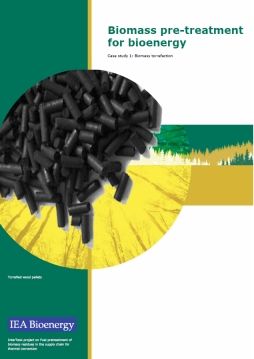Biomass pre-treatment for bioenergy – Case study 1: Biomass Torrefaction
Publications
 This report, written by Michael Wild and Lotte Visser, analyses the effects of pretreatment on supply chain efficiency by comparing the energy consumption along the supply chain of White Wood Pellets (WWP) supply with Torrefied Wood Pellet (TWP) supply.
This report, written by Michael Wild and Lotte Visser, analyses the effects of pretreatment on supply chain efficiency by comparing the energy consumption along the supply chain of White Wood Pellets (WWP) supply with Torrefied Wood Pellet (TWP) supply.
While WWP have become a global standard energy commodity in the recent decade, TWP are just at the beginning of the industrial implementation phase. TWP are made using the same raw material as WWP, implementing an almost similar machinery set up with the additional roasting of biomass to increase the energy density (22,2 GJ/mt instead of 17,56 GJ/mt taken as industry average values) and improve the handling, storage and grinding properties.
Whether energy can be saved across the supply chain by producing torrefied wood pellets instead of white wood pellets depends on the balance between increased processing energy consumption and decreased transport energy consumption. For the supply chain analysed in this study, from Indonesia to Japan, overall energy savings of 6.7% at minimum can be reached by shifting from WWP to TWP, resulting from a 16% increase in bioenergy, used for drying and torrefaction, a reduction in the consumption of liquid fossil fuels of 20.9% (Diesel, MDO and IFO) and a 2.3% reduction of electricity consumption on MJ/GJ supplied basis. The energy reduction across the chain results in a 10.3% GHG emission reduction for TWP compared to WWP.
The additional torrefaction processing step of roasting the biomass, requires additional heat. This heat is partially supplied by the combustion of syngas which is released during the torrefaction process, reducing the required fuel wood input proportionally, resulting in a very similar overall thermal efficiency to WWP processing. The pelleting of torrefied wood does consume slightly more electricity than the pelleting of WWP per tonne pelletised but is slightly more efficient if compared on energy basis. (IBTC M&E study 2018).
A sensitivity analyses concerning the influence of shipping distance shows an increased advantage of TWP with increased shipping distances. The raw material moisture content also impacts the savings on otherwise similar supply hains, with increased moisture content reducing the relative advantage of TWP. This since the thermal efficiency in the TWP is lower, resulting in fewer savings when the drying energy becomes more dominant in the overall supply chain energy balance. As improved grinding characteristics is another benefit of torrefaction, this would allow for the use of briquettes instead of pellets in traditional power plants as coal mills coiuld grnd both pellets and briquettes. The production of briquettes requires less electricity, resulting in a 10.3% energy saving and 33% GHG saving across the chain.
